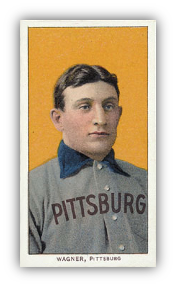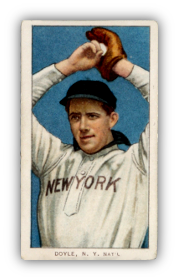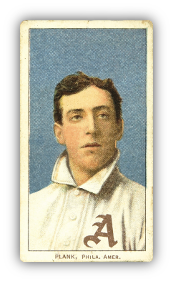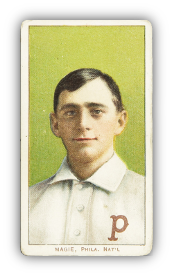
During production of the T206 set, four subjects, or a variation of one of these subjects, were printed for only a brief period of time. These short printings led to these four subjects being extremely scarce in relation to all other subjects in the set. Because of this scarcity, and the financial investment necessary to acquire them, these cards have come to be known as The Big Four. Many collectors consider their T206 set complete at 520 cards minus these four.
Honus Wagner

No card in the hobby is more iconic than the T206 Honus Wagner. Even though other cards are more scarce, none are in greater demand, command a similar premium or are as well known outside of the hobby.
The details surrounding Wagner's brief inclusion in the set have been a matter of great mystery and debate since the card was first confirmed by collectors in the 1930s. These debates generally consist of two theories. The first proposes that Wagner wanted and did not receive the financial compensation for which he asked. Others think, and a good deal of information corroborates, that Wagner did not want his likeness used with cigarettes. A May 10, 1933, Trenton Evening Times article quoted Wagner regarding an offer made to him during his career of $2,000 to endorse a cigarette as saying, "Smoking is all right for grown-ups, but it isn't good for kids. If they see that I'm boosting a cigarette, a lot of'em'll (sic) think they ought to smoke. I don't want to be responsible for that." Whether it was because of a lack of compensation or the tobacco products the cards were to be included with, it's apparent Wagner did not want his likeness used.
There are two similar accounts of Wagner being contacted for his permission to be included in the set. The first was written in the Sporting News on Oct. 4, 1912, and the other in the Cleveland Plain Dealer on Dec. 6, 1955. Both stories say that Wagner was sent a letter by a local representative asking for his permission to be included in the set. Like the Neal Ball letter, it likely included a permission slip to be signed by the player and returned. According to the two articles, in a return letter Wagner wrote that he had no interest in having his picture included with cigarettes. With the return letter, Wagner included a check for the compensation the local representative would have received had he secured Wagner's signature. The Dec. 6, 1955, article names John Gruber, the Pirates official scorer at the time, as the representative. Gruber is reported to have kept and framed the $10 check.
When printing and distribution began in 1909, the T206 set consisted of and was advertised as 150 subjects. Because of Wagner's refusal to sign the permission form, his card was not included with the 150 subjects in the early printings. This is evident by his exclusion from the Sovereign 150 printings, which were one of the first backs printed for the set and included only the original 150 subjects. As production of the set continued, the decision was made to add the Wagner card to the set. His card, along with two others, were first included in the printings for Sweet Caporal 150 factories No.25 and No.30 backs. This would be the only brand a Wagner card would be included with and the only two factories to distribute them. It's presumed at this time that Wagner was made aware of the cards and requested that no more be produced. In a1960 article in The American Weekly, Bill Levinson wrote, "When the cards appeared, the great shortstop promptly dashed off a letter that he did not approve of tobacco and would the company cease and desist."
At this time, printing had begun for sheets of Piedmont 150 backs that included Wagner's card. These sheets were pulled and never distributed. The only examples of Wagner cards with a Piedmont 150 back are thought to be cut from these undistributed sheets. After the Piedmont 150 sheets were pulled, no other Wagner cards were printed for the T206 set. However, his likeness did appear later in the second Sporting Life advertisement for the set, in August 1909.
Hobby estimates place the number of known T206 Wagners between 60 and 100 examples.
Joe Doyle (N.Y. Nat'l) Error Variation

When print group 3 first began production, the Joe Doyle caption incorrectly identified him with the N.Y. Nat'l team. Joe actually played for the American League N.Y. Highlanders, and it has been theorized that printers confused him with Larry Doyle, who played for the N.Y. Nat'l team. Whatever the reason, the error quickly was caught and the league designation of "Nat'l" was removed. Because of the timely correction, this variation can be found only with a Piedmont 350 back, and the number printed and distributed were low.
This variation first was discovered in 1980 by dealer Larry Frisch while filling an order for a T206 New York team set. Frisch checked his own collection and other hobby sources but could not find any mention of a Joe Doyle N.Y. Nat'l variation. He began placing ads in several hobby publications offering twice the common asking price for any Doyle cards. Collectors and dealers from all over the country responded to the ads and mailed in cards. No one is certain how many Doyle cards Frisch bought through these ads, but none turned out to be a N.Y. Nat'l variation. Then in 1987, a second example was discovered by dealer Bill Huggins. This card would ultimately be sold to Frisch for $10,000.
Since the first two discoveries in the '80s, only six additional Doyle N.Y. Nat'l variations have become known. The total population of eight examples makes it the scarcest of the 524 subjects on the complete set checklist.
Eddie Plank

Though not as scarce as the T206 Wagner, the mystery surrounding the Eddie Plank card has been even more confounding to collectors for the past 100 years. Unlike Wagner, the Plank card was printed with backs from both the 150 and 350 series. In the past, collectors have theorized that a printing plate was broken, explaining what was thought to be an extended period of time between printings. Others have thought that the Plank card was discontinued at one point and then reinstated. A careful examination of how the set was composed will show that neither is the case.
The Plank card's inclusion and subsequent removal from the set appears to be a similar situation to the Wagner. Plank, being one of the top players of the day likely would have been sent a permission letter from a representative of the ATC or ALC. But like Wagner, Plank was absent from the initial offering of 150 subjects. The Plank card, same as the Wagner, was first printed and distributed with Sweet Caporal 150 No.25 and No.30 backs. When the Piedmont 150 sheets were pulled to stop the distribution of Wagner, the Plank card was on those sheets as well and not distributed. This is evident by the known Piedmont 150 Plank examples that are all hand cut, like the Wagners. Of these few examples, one is thought to be the counterpart to and cut from the same sheet as the famous McNall/Gretzky Wagner.
After the Piedmont 150 printing in which the Plank cards were not distributed, several more printings took place that did not include the Plank card. The first was for distribution with Hindu brand cigarettes. In total, 102 major-league subjects were printed at this time, with a third of the available subjects, including Plank, not being printed. The next printing was for the transition of the set from the 150 to the 350 series, with subjects being printed with Piedmont 350 and El Principe De Gales backs. Of the available subjects that could be printed at this time, just more than half were included and just less than half were not printed. Again, Plank was in this large no-print group. Of these two print runs, many subjects from print group 1 were absent from one or the other, with a group of subjects that included Plank being absent from both.
The next printing was for Sweet Caporal 350 No.30 and included Plank. After the distribution of Plank cards with this back, no additional cards of his were printed. It is not known if a cease and desist of some kind was presented to the companies responsible for the set or if they simply chose to remove the card on their own.
Many estimates approximate the number of known Plank cards to be twice that of Wagners.
Sherry Magee (Magie) Error Variation

Unlike the other three of The Big Four, the Sherry Magee error variation hasn't garnered great attention or held a deep mystery, but it has quietly maintained its place within the group because of its scarcity in relation to other cards of the set. Beyond that, the details of the card are fairly straight forward.
When the Magee card was first printed during the initial Piedmont 150 run, his name in the caption was misspelled "Magie." This mistake was quickly caught and corrected with the proper spelling "Magee" limiting the number of error variations printed and distributed.
